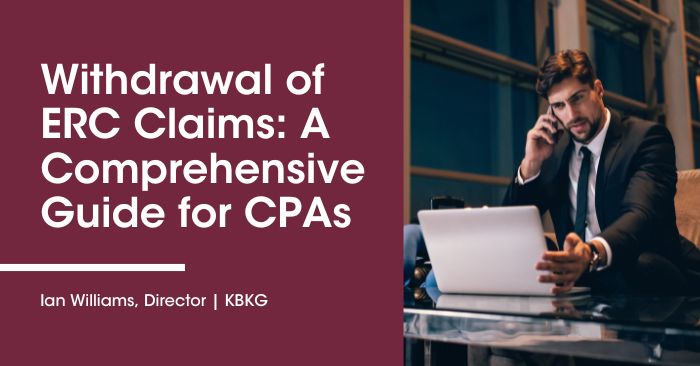Withdrawal of ERC Claims: A Comprehensive Guide for CPAs
Thought Leadership by Ian Williams, Director | KBKG
In IRS notice, IR-2023-193, released this week, the IRS has taken a significant step to protect small businesses and organizations from potential scams related to the Employee Retention Tax Credit (ERC) by introducing a novel withdrawal process.
This process is designed to assist employers who have submitted an ERC claim but are concerned about its accuracy. If an employer has filed a claim but has yet to receive a refund, they can avail of this option to withdraw their submission. This withdrawal option will help them avoid future repayment, interest, and penalties.
Even employers with ERTC claims still in the processing phase can withdraw their claim, preventing any disbursement for which they may not be eligible. The IRS is committed to helping businesses secure their employee retention payroll claims; this timely development is evidence of that commitment.
While the IRS created this withdrawal option as part of a larger effort to stem the high volume of fraudulent claims they were processing, they added an important note for those that were pushing those fraudulent claims.
“Those who willfully filed a fraudulent claim, or those who assisted or conspired in such conduct, should be aware that withdrawing a fraudulent claim will not exempt them from potential criminal investigation and prosecution.”
Who Can Request an ERC Claim Withdrawal?
ERC claim withdrawal is only an option for some. Certain conditions must be met according to the IRS to qualify for withdrawal. Here’s a breakdown of the eligibility criteria:
- Claim on Adjusted Employment Return: Employers are eligible for ERC refund claim withdrawal if they made a claim on an adjusted employment return, such as Forms 941-X, 943-X, 944-X, or CT-1X.
- Claim Solely for ERC: The adjusted return must have been filed exclusively to claim the ERC without any other adjustments.
- Full Withdrawal Desired: The employer must intend to withdraw the entire amount of their ERC claim.
- No Payment or Uncashed Check: The IRS must not have paid the ERC claim, or the IRS must have paid the claim, but the employer hasn’t cashed or deposited the refund check.
For taxpayers who do not meet these criteria, an alternative route to reduce or eliminate their ERC claim is to file an amended return, as detailed in the Correcting an ERC Claim – Amending a Return section of the frequently asked questions about the IRS Employee Retention Credit 2023 (ERC).
How to Withdraw an ERC Claim
For those who meet the above criteria and wish to proceed with the ERC claim withdrawal process, it’s essential to follow the specific instructions provided by the IRS. Here’s a step-by-step guide to help you navigate this process effectively:
- Consult with Payroll Companies (If Applicable)
If a professional payroll company filed the ERC claim on behalf of your client, you should initially consult with them. Depending on whether the ERC claim was filed individually or batched with others, the payroll company may need to submit the withdrawal request for the taxpayer.
- Submit a Fax Request (For Self-Filed Claims)
For taxpayers who filed their ERC claims, have yet to receive, cashed, or deposit a refund check, and have yet to be notified that their claim is under audit, the IRS has set up a special fax line to receive withdrawal requests. Submitting a fax request enables the IRS to halt processing before the refund is approved. However, if fax submission is not possible, clients can opt for mailing their request, although this method may take longer for the IRS to receive.
- Handling Audited Claims
Employers notified that they are under audit can send the withdrawal request directly to the assigned examiner or respond to the audit notice if no examiner has been appointed.
- Handling Uncashed Refund Checks
Clients who have received a refund check but haven’t cashed or deposited it can still withdraw their ERC claim. To do this, they should mail the voided check along with their withdrawal request, following the instructions available at IRS.gov/withdrawmyerc.
Early Challenges in ERC Calculations
It’s important to acknowledge that during the initial stages of the Employee Retention Credit (ERC) program, some payroll companies calculated ERC credits without thoroughly considering the eligibility criteria or the interaction with the Paycheck Protection Program (PPP). In cases where clients notified their payroll companies that they were eligible for the ERC, the credit was calculated and subsequently sent to the client. This early phase of ERC implementation highlights the complexities that CPAs and small business owners face in understanding and maximizing the program’s benefits. As ERC regulations continued to evolve, it became crucial for CPAs to navigate these complexities and provide accurate guidance to their clients. Understanding how ERC calculations were initially handled underscores the importance of staying up-to-date with changes in tax regulations and adapting to new information as it becomes available.
For Certified Public Accountants, staying informed about the intricacies of tax regulations and procedures, such as the Employee Retention Credit (ERC) claim withdrawal, is crucial to providing valuable guidance to your clients. By understanding the eligibility criteria and following the step-by-step withdrawal process, you can assist your clients in making informed financial decisions and ensuring compliance with IRS regulations. Whether consulting with payroll companies, submitting fax requests, or handling audited claims, your expertise in these matters will continue to be an invaluable asset to your clients. Stay up-to-date with the latest developments in tax regulations and continue to be the trusted advisor your clients rely on for financial success.
Further Reading
- To inquire about ERC Tax Credit Status, we suggest reading our blog, Where is My ERC Refund?
- We’ve written at length about how ERC tax credit scams have caused the IRS to place a moratorium on ERC. You can read several recent blogs like this blog, that blog, or this blog for more details on the pause and everything we know about it.


